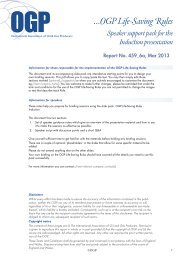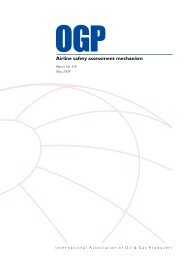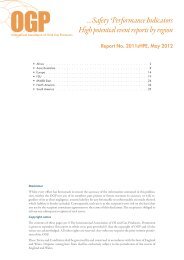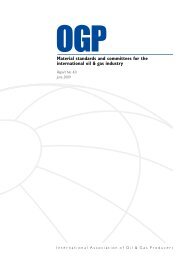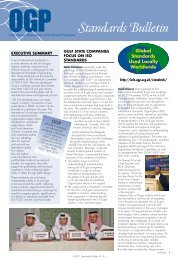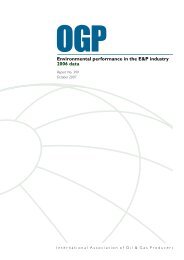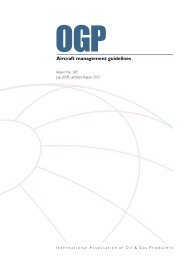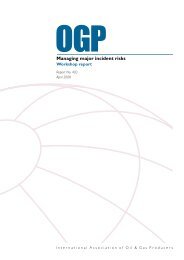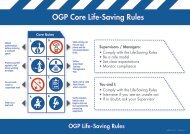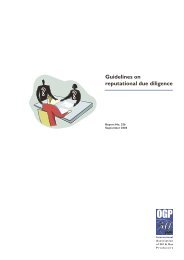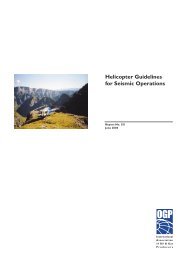Helicopter guidelines for land seismic & helirig operations - OGP
Helicopter guidelines for land seismic & helirig operations - OGP
Helicopter guidelines for land seismic & helirig operations - OGP
You also want an ePaper? Increase the reach of your titles
YUMPU automatically turns print PDFs into web optimized ePapers that Google loves.
<strong>Helicopter</strong> <strong>guidelines</strong> <strong>for</strong> <strong>land</strong> <strong>seismic</strong> & <strong>helirig</strong> <strong>operations</strong><br />
3.8 Minimum staffing – flight crew<br />
3.8.1 Number of Flight crew present and available on the <strong>operations</strong> should allow<br />
per<strong>for</strong>mance of the required <strong>operations</strong> without exceeding the maximum flying<br />
periods stipulated <strong>for</strong> the Flight Crews in section 9.2.<br />
3.8.2 Single/two pilot factors.<br />
Accident studies have shown that over 20% of <strong>seismic</strong> helicopter accidents could<br />
be prevented by having two pilots and in many other high workload environments<br />
of aviation, two pilot <strong>operations</strong> are accepted best practice. Two pilots should<br />
there<strong>for</strong>e be the preferred option. However, due to considerations of payload, aircraft<br />
per<strong>for</strong>mance and pilot resources, the use of a single pilot may be acceptable <strong>for</strong> certain<br />
<strong>operations</strong>, subject to a satisfactory risk assessment. The minimum factors to be taken<br />
into account when assessing the risk of using a single pilot include the following:<br />
1. <strong>Helicopter</strong> type<br />
a. Certified <strong>for</strong> single pilot in country of use.<br />
b. Equipped <strong>for</strong> single pilot long line and vertical ops with remote gauges, load<br />
meters, master caution, mirrors, bubble windows or floor windows.<br />
c. Remote flight following (satellite systems preferred)<br />
2. Pilot training<br />
a. Simulator or FTD training at a preferred frequency 12 months and not more<br />
than 24 months, when available <strong>for</strong> the aircraft type, completed as a single<br />
pilot, covering all emergencies <strong>for</strong> the type being flown, including tail rotor<br />
failure, engine failure, governor failures etc.<br />
b. Annual operational long line/ vertical reference training completed.<br />
c. Annual line check completed in addition to annual check flight.<br />
d. Airborne Decision Making course completed within 2 years by qualified<br />
provider or facilitator.<br />
e. Annual Inadvertent IMC training and competency test completed.<br />
3. Flight environment<br />
a. Planned and conducted in day, VFR only.<br />
b. Uncongested airspace – likelihood of air collision minimal, including other<br />
aircraft on same task. Radio procedures in place <strong>for</strong> airspace separation.<br />
c. Navigation complexity versus navigation equipment in use.<br />
d. Types and size of <strong>land</strong>ing areas suitable <strong>for</strong> single pilot crew. No additional<br />
lookout required.<br />
e. Type of flight. Long transits, particularly those including a point of no return<br />
and/or in remote hostile areas (eg arctic) should have 2 pilots.<br />
4. Fatigue Management<br />
a. Single pilot flight duty hours applied without extension (See section 9.2)<br />
b. Satisfactory environmental factors (extreme heat or cold effectively<br />
mitigated).<br />
Failure to meet all of the factors listed above should result in a two pilot crew or<br />
additional mitigation factors being applied.<br />
© <strong>OGP</strong><br />
9



